Struggling to fit a lot of content into a compact, lightweight notebook or planner? Thick, bulky pages can make your product heavy and cumbersome, ruining the user experience and increasing shipping costs. Bible paper offers an elegant solution, providing incredible thinness without sacrificing quality and feel, making your premium products stand out.
Bible paper, also known as "scritta paper," is a very thin, lightweight, yet durable and opaque wood-pulp paper. Its key feature is a low grammage (25-40 gsm) combined with high opacity, which prevents text from showing through. This unique balance makes it ideal for products requiring many pages in a compact form, like Bibles, dictionaries, high-end planners, and legal books, significantly impacting a product’s final weight, feel, and cost.
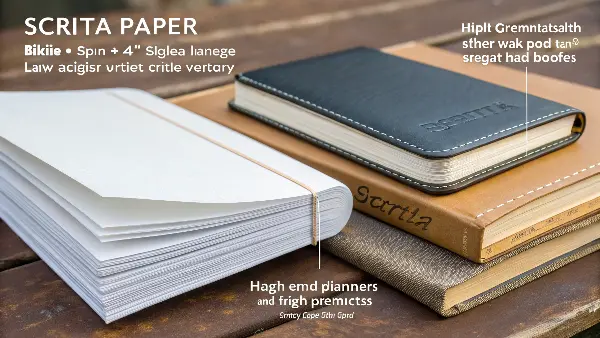
This unique combination of properties isn’t magic; it comes from a very specific manufacturing process. As a stationery supplier, I’ve worked with many clients like Michael, a product manager in Germany, who need to understand these nuances to create the perfect product. Understanding these details can help you decide if it’s the right fit for your next product line. Let’s explore what really makes this paper so special and how you can leverage it for your brand.
What Defines Bible Paper’s Unique Weight and Thinness?
Have you ever been amazed by how a 1,000-page book can feel so light? Choosing the wrong paper weight can lead to products that are too heavy or feel cheap. It’s a constant balancing act between page count and portability. Understanding the concept of grams per square meter (gsm) in Bible paper is the key to mastering this balance for your products.
Bible paper’s defining characteristic is its extremely low weight, typically ranging from 25 to 40 grams per square meter (gsm). This is significantly lighter than standard office paper (around 80 gsm) or even typical book paper (60-90 gsm). This extreme thinness is achieved through a specialized manufacturing process using fine wood pulp, often combined with cotton or linen fibers for added strength, allowing for a high page count without creating a bulky, unusable product.
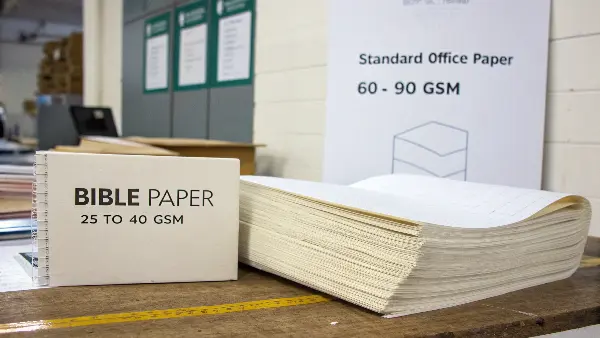
The term "gsm" is our industry standard for measuring paper density, and for Bible paper, this number is everything. A lower gsm means a thinner, lighter sheet. But thinness alone isn’t enough; the paper must also be strong. During my time working on a large order of compact journals for a European client, we tested several gsm options. The client wanted a 500-page journal that didn’t feel like a brick.
We settled on a 35 gsm paper. It struck the perfect balance. It was thin enough to keep the journal sleek and portable, but strong enough to withstand daily use. The manufacturing process uses specific pulp fibers, like esparto grass or flax, which are known for their strength and length. These fibers are beaten and refined to create a very dense, yet thin, paper sheet. This process ensures the paper doesn’t tear easily, even at such a low weight.
Here’s a quick comparison to put it in perspective:
| Paper Type | Typical GSM Range | Common Uses | Key Characteristic |
|---|---|---|---|
| Bible Paper | 25 – 40 gsm | Bibles, Dictionaries, Planners | Ultra-thin, lightweight |
| Notebook Paper | 60 – 90 gsm | School Notebooks, Journals | Everyday writing |
| Office Paper | 75 – 90 gsm | Printing, Copying | Standard thickness |
| Cardstock | 160 – 300 gsm | Business Cards, Covers | Thick, rigid |
Choosing the right gsm is a critical decision in product development. It directly impacts the final product’s thickness, weight, and user perception.
How is High Opacity Achieved in Such Thin Paper?
You’ve chosen a thin paper to keep your product lightweight, but now you worry about the ink showing through to the other side. This "ghosting" or "bleed-through" can make a premium planner or journal look cheap and be frustrating to use. The secret lies in creating high opacity without adding bulk, a challenge that Bible paper elegantly solves.
High opacity in Bible paper is achieved by adding mineral fillers like titanium dioxide and calcium carbonate to the paper pulp during production. These pigments are distributed evenly among the paper fibers, scattering light and effectively preventing ink from showing through to the reverse side. This allows the paper to remain incredibly thin and lightweight while still being suitable for double-sided printing, a crucial feature for high-page-count products.
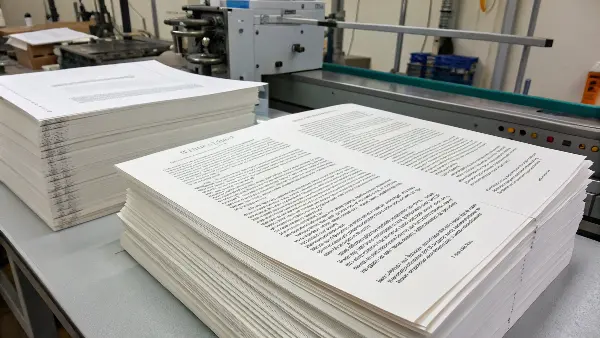
Opacity is arguably the most impressive quality of Bible paper. It seems counterintuitive—how can a paper so thin not be transparent? The answer is in the science of its composition. The mineral fillers are the heroes here. Think of them as millions of tiny mirrors embedded within the paper. When light hits the page, these particles scatter it in all directions, making the paper appear opaque. Titanium dioxide is particularly effective and is a premium filler that significantly boosts opacity.
I remember a project with a client who wanted to develop a series of pocket-sized reference guides. The page count was high, and the text was dense. Show-through was their biggest concern. We provided samples of 30 gsm Bible paper with different levels of filler content. By comparing a standard thin paper with a high-opacity Bible paper, the difference was immediately clear. The text on the reverse side of the Bible paper was barely noticeable.
This process is a delicate balancing act. Adding too much filler can make the paper brittle or affect its texture. Our manufacturing partners have perfected this process, ensuring the fillers are integrated without compromising the paper’s strength or smooth feel. This careful formulation is what allows publishers to print on both sides of a 28 gsm sheet without the text interfering, delivering a clean and pleasant reading experience.
What Are the Key Printing Considerations for Bible Paper?
So you’ve sourced the perfect thin, opaque Bible paper. But now you face the next hurdle: printing on it. Printing on such a delicate material is not the same as printing on standard 80 gsm office paper. The ink can bleed, the pages can wrinkle, and the machinery needs special calibration. If not handled correctly, all the benefits of the paper can be lost in a smudged, low-quality print job.
Printing on Bible paper requires careful management of ink absorption and drying time. Because the paper is thin and dense, printers must use specialized inks with low viscosity and control the amount applied to prevent bleed-through. Web-fed offset printing is often preferred for large runs as it offers greater control over paper tension and ink application. Proper finishing, like folding and binding, also needs precision to avoid damaging the delicate pages.
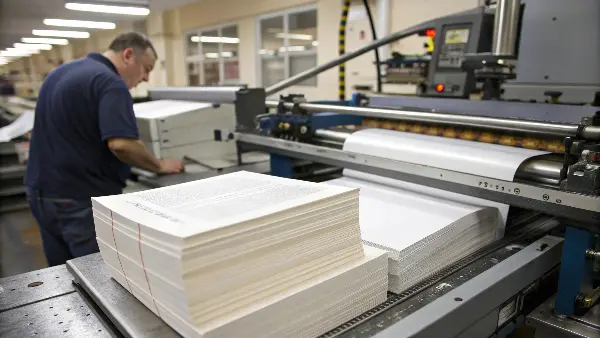
When we work with clients on projects using Bible paper, the printing conversation starts early. It’s not just about the paper; it’s about how the paper and ink work together. The goal is to get crisp, clear text without any feathering or bleed-through.
Ink and Drying
The type of ink is critical. We often recommend inks that are formulated to sit on the surface of the paper rather than being fully absorbed. This requires controlled drying processes, often using heat or UV light, to set the ink quickly before it has a chance to soak through the sheet. We ran into this issue when developing a daily planner with intricate, fine-line designs. The initial ink tests resulted in fuzzy lines. By switching to a faster-drying ink and adjusting the press settings, we achieved the sharp detail the designer envisioned.
Printing Press and Tension
The physical handling of the paper is another challenge. Bible paper is so lightweight that it can easily tear or wrinkle in a standard printing press. Web-fed presses, which use continuous rolls of paper, are ideal because they maintain constant tension on the paper sheet throughout the printing process. This stability is key to ensuring consistent print quality and preventing registration errors (where colors don’t line up correctly). Sheet-fed presses can also be used, but they require highly skilled operators and specialized equipment to handle the delicate sheets properly.
Getting it right is a collaboration between the product designer, the paper supplier, and the printer. Open communication ensures everyone understands the material’s unique properties and limitations.
Is Bible Paper the Right Choice for Your Next Stationery Project?
You might be thinking, "This is great, but my company doesn’t make Bibles." It’s easy to get stuck on the name, but the applications for this unique paper go far beyond religious texts. Choosing the right material can elevate your product from ordinary to premium, but using it in the wrong context can be a costly mistake. So, when should you consider it?
Bible paper is the ideal choice for any stationery project where a high page count needs to fit into a slim, lightweight, and premium-feeling product. Beyond Bibles and dictionaries, it is perfect for high-end daily planners, extensive reference manuals, luxury journals, and legal or pharmaceutical inserts. If your product’s core value proposition includes portability and packing in a large volume of information, Bible paper is an excellent material to consider.
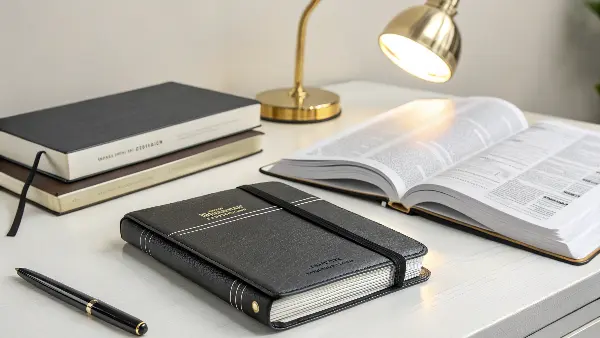
Let’s break down where Bible paper truly shines in the stationery world. I’ve seen it used to great success in projects where the "wow" factor comes from the product’s surprising lightness and density. Think about a 365-day planner. Using standard paper, it would be thick and heavy. With 40 gsm Bible paper, you can create a planner that contains the same number of pages but is half the thickness and weight. This immediately communicates a sense of thoughtful design and quality.
Ideal Applications
- Premium Planners and Journals: Especially for daily or undated formats with over 300 pages. The smooth texture and crispness of the pages enhance the user experience.
- Reference Guides: For professionals like engineers, doctors, or lawyers who need access to a large amount of information in a portable format.
- Luxury Notebooks: For brands targeting writers and creatives who appreciate high-quality materials and want a notebook with a very high page count for all their ideas.
- Product Inserts and Manuals: For high-end electronics or pharmaceuticals where detailed instructions must be included in a small package.
When to Reconsider
However, it’s not the right fit for every project.
- Art Journals: The paper is not designed to handle heavy ink, markers, or watercolor. Fountain pen users might experience some ghosting, depending on the ink and nib.
- Children’s Books: It lacks the durability needed to withstand handling by young children.
- Standard Office Notebooks: For everyday note-taking, a standard 70-80 gsm paper is more cost-effective and robust.
The decision comes down to your product’s purpose and target user. If you’re designing for elegance, portability, and high information density, Bible paper is a fantastic option.
How Do You Source High-Quality Bible Paper?
You’ve decided Bible paper is perfect for your new product line. Now comes the most important step: finding a reliable supplier. Sourcing specialty paper isn’t like buying standard copy paper. The quality can vary dramatically between manufacturers, and a poor choice can lead to production delays, inconsistent quality, and a final product that fails to meet your brand’s standards.
To source high-quality Bible paper, partner with an experienced supplier who provides detailed technical specifications, including gsm, opacity percentage, and brightness level. Always request and test physical samples with your intended pens and printing methods. A reliable partner like Panoffices should also offer a stable supply chain, quality control guarantees, and expertise in handling the specific printing and binding requirements for this delicate material.
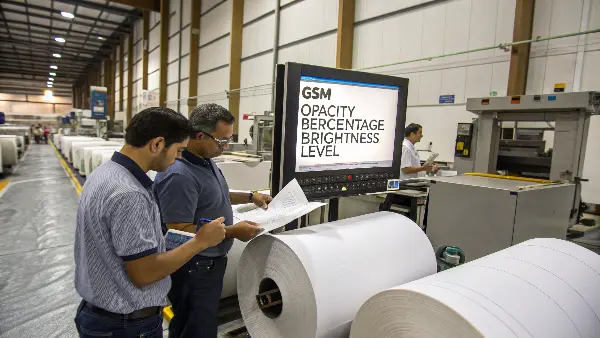
As a B2B supplier, we guide clients like Michael through this process every day. Sourcing isn’t just about finding the lowest price; it’s about finding a partner who understands your vision and can execute it flawlessly.
Key Questions to Ask a Potential Supplier
- Can you provide detailed technical specifications? Don’t just ask for "30 gsm Bible paper." Ask for opacity ratings (ideally 85% or higher), brightness levels, and the types of pulp used. This data allows you to make an informed comparison.
- What is your sample policy? Never commit to a large order without testing samples. You need to write on them, print on them, and see how they feel. We always provide a range of samples so our clients can make the best choice for their specific application.
- What does your quality control process look like? Ask how they ensure consistency across different batches. Quality control should cover everything from paper weight and color to the absence of defects.
- Can you advise on printing and finishing? A good supplier doesn’t just sell paper. They understand how it performs. They should be able to connect you with printers who have experience with Bible paper or provide advice to your existing partners.
A while back, we worked with a startup launching a premium journal. They had a great design but were new to manufacturing. By guiding them through sample testing and connecting them with a printer in our network who specialized in thin paper, we helped them avoid common pitfalls. The final product was a huge success because every element, from the paper to the printing, was handled with expertise.
Conclusion
Bible paper is much more than just a material for one type of book. It’s an innovative solution for creating thin, lightweight, and high-capacity stationery. By understanding its key properties—low weight, high opacity, and specific printing needs—you can make informed decisions that elevate your product designs and deliver exceptional value to your customers.

